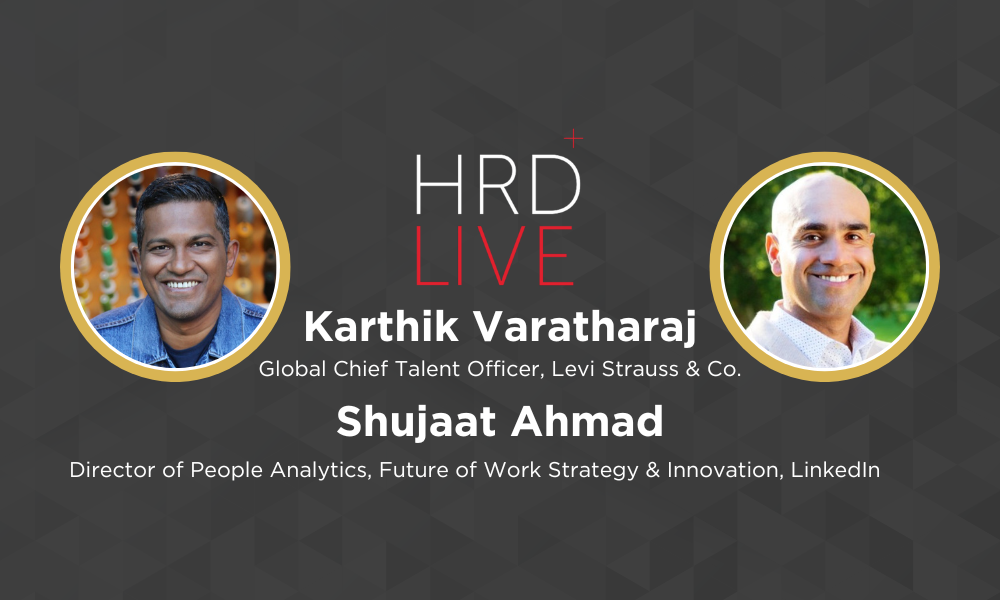Creating an inclusive, data-driven future of work: Lessons from LinkedIn and Levi’s
- 5 Min Read
Levi’s Chief Talent Officer and LinkedIn’s Director of Future of Work Strategy and People Analytics share perspectives on building an equitable, data-driven future of work
- Author: Benjamin Broomfield
- Date published: Jul 26, 2023
- Categories

Podcast: Play in new window | Download
Subscribe: RSS
“Your future of work strategy is your DEI&B strategy,” argues Shujaat Ahmad, Director of People Analytics and Future of Work Strategy and Innovation at LinkedIn. Creating unity in these strategies requires data-driven future of work planning.
Ahmad is joined on the HRD Live Podcast by Karthik Varatharaj, Global Chief Talent Officer at Levi Strauss & Co, for an in-depth discussion on using data to guarantee an equitable and inclusive future of work.
Foundations of an inclusive, data-driven future of work
To begin designing an inclusive future of work strategy, Ahmad argues you must ask why. “For a lot of companies, they’re doing it because it’s good for the business,” he states. “It’s either good from a customer’s perspective or it’s good because they want to retain and attract talent.”
Data insights then offer the route and guidance for achieving this goal. Monitoring progress keeps you on course and nudges you to course correct where necessary. Simply put, if you wish to create an inclusive future of work, “You cannot do this without being able to measure and iterate along the way.”
Echoing this perspective, Varatharaj confirms Levi Strauss & Co.’s future of work strategy is a natural outcome of its DEI&B strategy. “Data and insights reinforce, validate, and give us signals as to where we should be targeting our efforts, he notes.”
“The data we picked up from listening surveys and external benchmarking has truly helped us create a practical framework that is, supportive of the diversity of our employee base, not just in the US, but globally.”
Empowering managers with a data-driven future of work
As a values-driven organization, Levi Strauss & Co. leads with a ‘profit through principles’ approach. But, with limited budgets for investment, there is always a trade-off when investing in strategies and policies that will drive impact and rally the organization. Varatharaj emphasizes the role managers play at these crucial inflection points.
“A core piece of what we’ve done at Levi Strauss and Co is manager empowerment. Having managers and empowering them to have agency over how they make decisions, and encouraging them to lean into flexibility, empathy, and psychological safety.
“We set a central strategy and framework, and we allow managers the power to play within that framework to make decisions that best work for them. And it’s been really successful so far.”
Ahmad underpinned this argument with an analysis of data-driven DEI&B.
“In the DEI&B world, there are two levels. You go to the abstract level, where we start at the top, look at data, and understand where sentiments are and what’s working for different populations.
“But the action has to be coupled with a more grounded approach where employee resource groups come into play. In the culture of storytelling, managers learn from other managers, peer-to-peer learning is very strong.”
He argues by building stories that add texture to data and employee insights, managers buy into more grounded stories that foster a culture of inclusion.
Test, learn, iterate
Approaching an inclusive, data-driven future of work strategy requires an iterative, adaptive approach to strategic planning and execution. HR should empower managers to experiment and equip them with data to test and learn. Ahmad highlights sentiment data and behavioral data as two excellent data sources, alongside talent metrics, that allow organizations to innovate and myth-bust unsuccessful and harmful policies and practices.
Varatharaj also vies for this approach to strategic planning, highlighting the work at Levi Strauss and Co. He adds that an iterative and transparent approach to future of work planning can prepare employees for change.
“Employee sentiment is always going to be grounded in facts. But also, what’s happening on a macro level? Is there guidance from the CDC or other external benchmarking research bodies which inform the decision-making?
“Employees appreciate the transparency to understand why something is shifting, and to have the time to adequately adapt to it once things are rolled out. We take this iterative approach.”
Tune in to the full HRD Live Podcast episode to hear further examples of data-driven future of work planning at LinkedIn and Levi Strauss and Co, alongside analysis from Ahmad and Varatharaj on implementing data-led DEI&B planning at the executive level.
Timestamps
00:09 – Introduction
01:14 – What role do insights and data play in continuing to intertwine DEI&B strategy within future of work strategy?
05:15 – How can organizations meet people where they are when not everyone has the same vision for DEI&B and the Future of Work?
08:07 – What are some strategies for generating buy-in and engagement at the manager level?
12:39 – What about at the executive level? How can HR leaders influence executive decision-making based on DEI&B data insights?
16:14 – How would you recommend using data insights to innovate, test, execute, and prove future of work theories in practice?
_______________
Karthik Varatharaj is the Global Chief Talent Officer at Levi Strauss & Co. He oversees all aspects of talent and culture, including acquisition, career development, and employee engagement, and has led and executed multiple global people transformation efforts spanning Retail, Financial Services, and Technology. Both in and out of the office, he strives to advance diversity, equity, and inclusion in all that he does.
Shujaat Ahmad is the Director of People Analytics and Future of Work Strategy and Innovation at LinkedIn. Shujaat is also the Global Co-Chair of Embrace ERG, a global LinkedIn employee resource group, and a guest lecturer at the Wharton School. He is an established trusted strategic advisor to global executive business and talent leadership. He focuses on myth-busting beliefs and influencing mindset change to align evidence-based talent strategy with business strategy and make people “the” enabler of competitive advantage.








